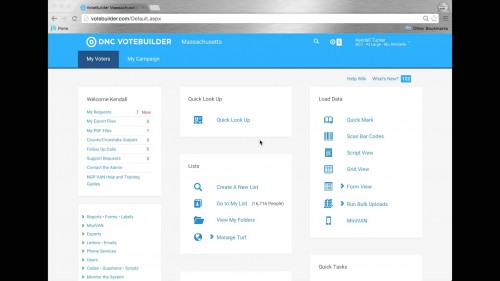
Too few people are concerned that a national political party has the technical ability to pull the plug on a campaign whenever it wants. When news broke that the DNC had indefinitely revoked the Sanders’ campaign’s access to essential voter data the story quickly coalesced around the facts of the data breach and the reaction by the campaigns and the party. At no point though, have we stopped and asked why or even how the Democratic National Committee controls the data that goes through the tools built and maintained by their private vendor NGP VAN.
This is a classic politics of technology moment. Not only is this a clear example of a technology that was built to maintain a certain kind of power hierarchy, it also seems to be ensconced in organized ignorance. VoteBuilder, what is usually referred to in the media as simply “voter data”, is actually an entire suite of tools used to collect, organize, and view who a campaign has spoken to and who they have yet to meet. VoteBuilder has been an indispensible tool for over a decade, having been used by small town city council races right up through presidential elections, and yet it does not even have a Wikipedia page. I’ve had some limited first hand experience with the software but for the most part this technology is a black box: its inner workings are a total mystery to me and, I suspect, most Americans.
It is besides the point that the Sanders campaign regained access to their data within 24 hours. The ability to totally shut out a campaign from the kind of information that has been rightly and repeatedly called “the lifeblood of campaigning” has to be designed into the software. At some point a DNC executive decided that it may be necessary to immediately revoke a campaign’s access to voter files. This should be terrifying on its own merrits but it is particularly concerning given that journalists are coming back from early primary states saying “it was hard to tell where the Democratic Party’s office ended and the Clinton office began.”
A lot has been said about the Republican race. In fact, the Republicans have been so thouroughly covered by the media that now the disparity between them and the Democrats has become a major story. And while Trump’s media savy has a lot to do with the “push” toward more Republican covereage there is also an active “pull” that drags Democrats out of the spotlight. DNC chair Debbie Wasserman-Shultz has barely tried to hide the fact that she is doing everything possible to make Clinton’s candidacy look and feel inevitable, which has included shortening the debate calendar from 26 in 2008 to six in 2016, and hiding those six on weekends and far away from actual primaries. Even if Shultz were replaced, as so many petitions over the weekend have demanded, the establishment left is still contained within a party that installs kill switches on campaigns. That is a structural problem that comes before, and is much larger than, Shultz or any one chairperson.
I’ll just end here with a request that we look at how technologies like VoteBuilder have centralized the authority of political parties (Republicans have a similar system called Voter Vault) and strong actors in ways that are both more powerful, but less noticeable than the old Tammany Hall machine politics of the early 20th century. We may want to bring to bear the wealth of knowledge on algorithms catalogued here by Microsoft Research’s Social Media Collective and add to the relative dearth of knowledge specifically about voter databases. Last week there was a major display of undemocratic power weilded on a popular campaign and we run the risk of not even noticing the means by which that power was exercised.
David is on Twitter.
